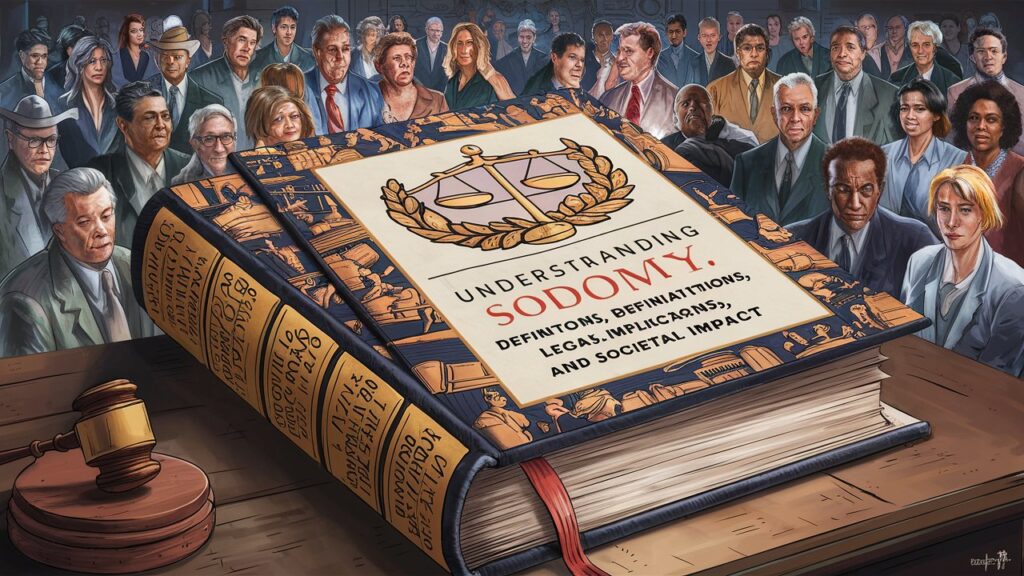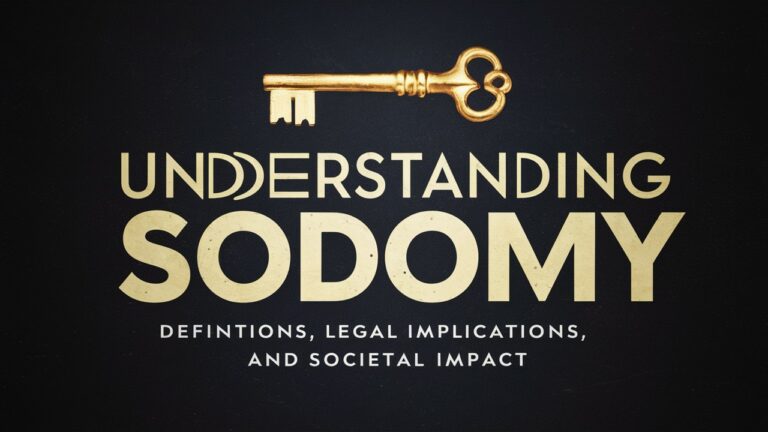Introduction
The term “sodomy” has historically carried legal, cultural, and moral weight, often sparking debates about consent, bodily autonomy, and human rights. When discussing the phrase “sodomising a woman,” it is critical to approach the topic with sensitivity and clarity, as it involves non-consensual acts of sexual violence that inflict profound physical and psychological harm. This article aims to define the term, explore its legal and societal implications, address common misconceptions, and provide resources for survivors. By fostering informed dialogue, we can promote awareness, justice, and healing.
1. Defining Sodomy: What Does Sodomising a Woman Mean?
Sodomy, in legal and colloquial contexts, refers to anal or oral penetration, often without consent. When applied to the act of “sodomising a woman,” it specifically describes non-consensual anal penetration perpetrated against a female individual. This act constitutes sexual assault and is a criminal offense in most jurisdictions. It is essential to distinguish between consensual sexual acts and violent violations: while consensual anal intercourse is a personal choice between adults, sodomy as an act of violence disregards bodily autonomy and inflicts trauma. Understanding this distinction is vital to addressing survivor experiences and legal accountability.
2. Legal Definitions and Criminal Consequences
Legally, sodomy laws have evolved significantly. Historically, many regions criminalized all forms of anal or oral sex, regardless of consent. However, modern legal frameworks increasingly focus on consent as the defining factor. Non-consensual sodomy is classified as sexual assault or rape in many countries, carrying severe penalties, including imprisonment. For instance, under the U.K. Sexual Offences Act 2003, non-consensual anal penetration is treated as rape. In the U.S., state laws vary, but federal guidelines classify it as aggravated sexual abuse. Survivors have the right to report such crimes, and legal systems are obligated to pursue justice while protecting victim confidentiality.
3. Physical and Psychological Impacts on Survivors
The aftermath of sodomy as sexual violence can be devastating. Physically, survivors may experience tearing, infections, chronic pain, or long-term gastrointestinal issues. Psychological trauma often includes post-traumatic stress disorder (PTSD), depression, anxiety, and feelings of shame or isolation. Societal stigma surrounding sexual violence can exacerbate these effects, discouraging survivors from seeking help. Medical professionals emphasize the importance of immediate post-assault care, including forensic exams and mental health support, to mitigate harm and aid recovery.
4. Consent: The Cornerstone of Sexual Autonomy
Consent is the foundation of ethical sexual interaction. Sodomising a woman without her explicit, voluntary agreement is a violation of her bodily autonomy and human rights. Consent must be informed, enthusiastic, and revocable at any time. Cultural myths, such as the idea that marriage or prior relationships justify non-consensual acts, perpetuate harmful stereotypes. Education campaigns, like those promoted by the #MeToo movement, stress the importance of clear communication and respect for boundaries in all intimate encounters.

5. Cultural and Social Perspectives on Sodomy
Attitudes toward sodomy vary widely across cultures and religions. Some societies stigmatize all forms of anal intercourse, conflating consensual acts with criminal behavior. Others focus on condemning non-consensual violence while respecting private, adult choices. Religious doctrines, such as those in conservative interpretations of Abrahamic faiths, have historically condemned sodomy, influencing legal and social norms. However, progressive movements advocate for separating moral judgments from legal rights, emphasizing that sexual violence—not consensual behavior—should be the target of societal condemnation.
6. Supporting Survivors: Resources and Advocacy
Survivors of sodomy and sexual violence require compassionate, multidisciplinary support. Organizations like RAINN (Rape, Abuse & Incest National Network) and local crisis centers offer hotlines, counseling, and legal aid. Medical professionals recommend emergency contraception and STI testing post-assault, while therapists specialize in trauma-informed care. Advocacy groups also work to reform legal systems, ensuring survivors’ voices are heard in court and reducing retraumatization during trials. Public awareness campaigns, such as Denim Day, challenge victim-blaming myths and promote solidarity.
7. Prevention and Education: Building a Safer Society
Preventing sexual violence requires systemic change. Comprehensive sex education programs that teach consent, boundaries, and respect can reduce incidents of assault. Workplace training and bystander intervention initiatives empower communities to identify and disrupt predatory behavior. Legal reforms, such as abolishing statutes of limitations for sexual offenses, ensure survivors have adequate time to pursue justice. By fostering cultures of accountability and empathy, societies can dismantle the power imbalances that enable violence.
Conclusion
Sodomising a woman is an act of sexual violence with far-reaching consequences for survivors and society. Through clear definitions, legal accountability, survivor-centered support, and proactive education, we can challenge the norms that perpetuate such crimes. Empathy, awareness, and advocacy are essential tools in creating a world where bodily autonomy is respected and survivors are met with justice, not stigma.
Frequently Asked Questions (FAQs)
Q1: Is sodomy illegal even if consensual?
A1: Laws vary by region. Many countries, including the U.S., have decriminalized consensual sodomy between adults, but some nations still impose penalties. Non-consensual sodomy is universally recognized as a crime.
Q2: Can a spouse be charged with sodomising their partner?
A2: Yes. Marital status does not negate the need for consent. Non-consensual acts within marriage are classified as sexual assault.
Q3: How can survivors seek help anonymously?
A3: Hotlines like RAINN (1-800-656-HOPE) provide confidential support. Online chat services and local shelters also prioritize survivor privacy.
Q4: What legal options exist for survivors?
A4: Survivors can file police reports, seek restraining orders, and pursue civil lawsuits. Legal aid organizations often assist with navigating these processes.
Q5: How can I support a loved one who has experienced this trauma?
A5: Listen without judgment, respect their autonomy, and encourage professional counseling. Avoid pressuring them to report the crime unless they choose to.
This article aims to inform and empower readers while prioritizing sensitivity toward survivors. For urgent support, contact local emergency services or a trusted crisis hotline.
